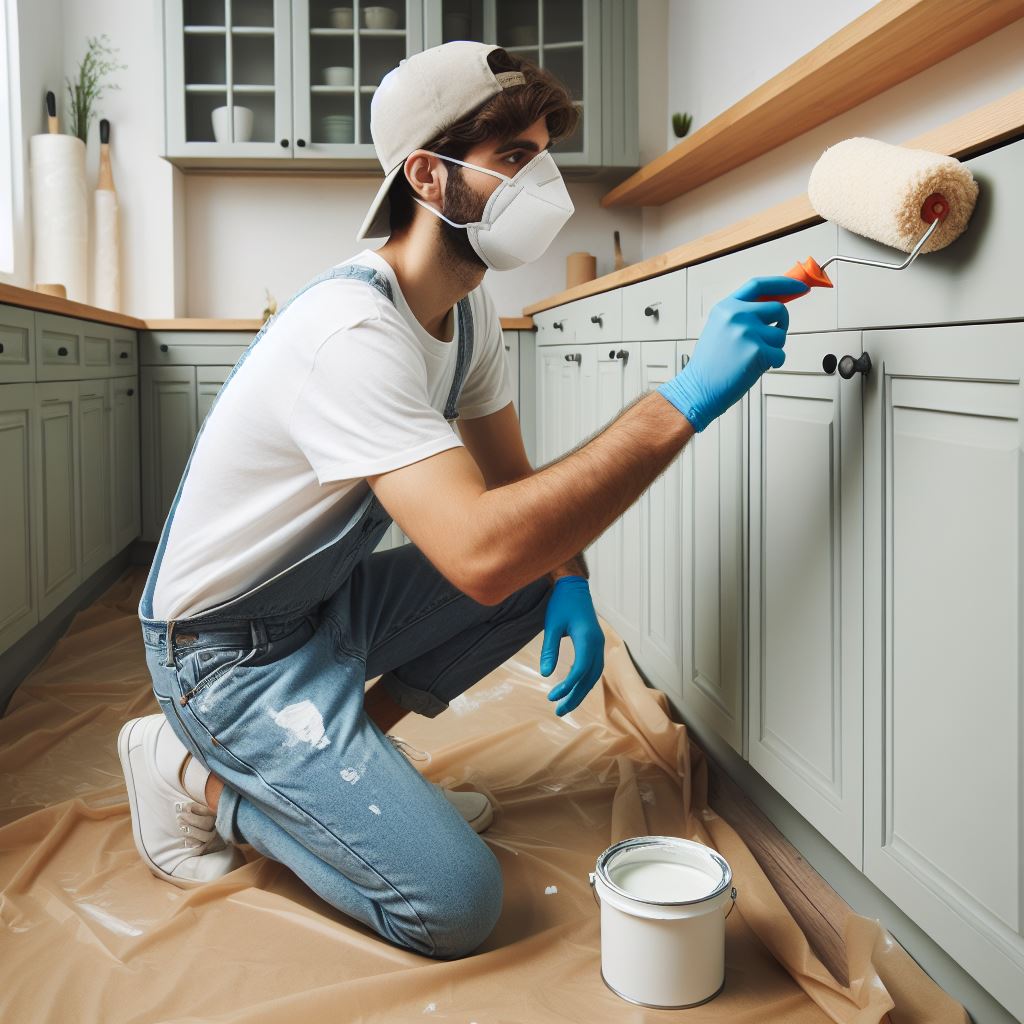Introduction
Effective home renovations hinge on meticulous budgeting.
It’s the key to turning dreams into reality and avoiding financial headaches that can dampen the excitement of a project.
Our focus today is on empowering you with the knowledge and skills to tackle DIY bathroom updates without draining your wallet.
We understand the desire for a stylish bathroom without the hefty price tag.
With strategic planning and creativity, you can achieve a fresh, modern look on a budget.
As we embark on this budget-friendly journey, we’ll uncover innovative approaches to revitalize your bathroom space.
From simple tweaks like paint and hardware updates to more strategic upgrades such as maximizing storage and playing with lighting, we’re here to guide you through practical steps that deliver a big impact.
These changes not only enhance aesthetics but also improve functionality.
Moreover, we’ll share insights on where to allocate your budget wisely, ensuring you get the best value for your money.
Practical tips and tricks will be at the forefront, making the DIY process both enjoyable and rewarding.
So, are you ready to explore the secrets of budget-savvy bathroom transformations?
Let’s dive into the fascinating realm of affordable, yet remarkable, home improvement!
Planning Your Budget
Assessing your current financial situation
Before embarking on any bathroom updates, it is essential to assess your current financial situation.
Take a close look at your income, expenses, and savings to determine how much you can comfortably allocate to this project.
Additionally, consider any upcoming financial obligations or unexpected expenses that may arise during the renovation process.
Determining a realistic budget range for the bathroom updates
Once you have a clear understanding of your financial situation, it’s time to determine a realistic budget range for your bathroom updates.
This will ensure that you don’t overspend or strain your finances.
Consider your priorities and how much you are willing to invest in improving your bathroom.
Remember, setting a sensible budget will help you make informed decisions throughout the project.
Breaking down the costs of different components (e.g., fixtures, tiles, paint, etc.)
Now that you have a budget range in mind, it’s important to break down the costs of different components involved in the bathroom updates.
Consider elements such as fixtures, tiles, paint, and any other materials you may need.
This breakdown will help you allocate a portion of your budget to each element, ensuring a balanced approach to your updates.
Researching and comparing prices of materials and products
Once you have a list of the necessary materials and components, it’s time to research and compare prices.
Visit local home improvement stores, browse online marketplaces, and take advantage of sales or discounts.
By doing thorough research, you can make sure you get the best deals without compromising quality.
Tips for setting aside a contingency fund for unexpected expenses
Despite careful planning, unexpected expenses can still occur during a bathroom update project. That’s why it’s crucial to set aside a contingency fund.
Allocate a portion of your budget specifically for unforeseen circumstances, such as plumbing issues, structural problems, or unexpected material costs.
By having a contingency fund, you can handle any surprises that come your way, ensuring a smoother renovation process.
In essence, planning your budget for bathroom updates requires a comprehensive assessment of your financial situation, determining a realistic budget range, breaking down costs, researching prices, and setting aside a contingency fund.
By following these steps, you can embark on your DIY bathroom updates project confidently, knowing you have a clear financial plan in place.
Read: Bamboo Flooring: Durable and Green
Prioritizing Updates
Key areas of the bathroom that need improvement
When it comes to budget-friendly bathroom updates, it is important to identify the key areas that need improvement.
Analyzing the overall condition of your bathroom allows you to prioritize updates effectively.
First, assess the functionality of your bathroom fixtures such as faucets, showerheads, and toilets.
Determine if any of these need repair or replacement due to wear and tear or inefficiency.
Next, examine the walls, flooring, and tiles.
Look for signs of damage, such as cracks or stains, and consider updates that can make a significant impact on the overall aesthetic.
Lastly, evaluate the storage options in your bathroom.
If you find yourself constantly struggling with limited space, consider upgrading or adding storage solutions to maximize functionality.
The cost versus impact analysis for each update
To make the most of your budget, it is crucial to consider the cost versus impact analysis for each update.
Some updates may require more financial investment but offer a higher impact on the overall appearance and functionality of your bathroom.
For example, replacing old faucets and showerheads can instantly give your bathroom a fresh and updated look without breaking the bank.
Additionally, investing in good quality paint and repainting the walls can completely transform the ambiance of the space, providing a significant impact for a relatively low cost.
On the other hand, costly updates like replacing flooring or installing new tiles may have a higher impact but require a larger budget.
It is important to carefully weigh the potential return on investment for each update before making a decision.
Essential updates that provide the most significant transformation on a budget
If you are looking to make significant transformations on a tight budget, here are some essential updates that can deliver the most significant impact:
- Repainting: A fresh coat of paint can instantly brighten up your bathroom and give it a modern and clean look.
- Upgrading fixtures: Replace outdated faucets, showerheads, and cabinet handles with more modern options for a quick and noticeable improvement.
- Lighting: Upgrade your bathroom lighting to achieve a brighter and more inviting atmosphere. Consider adding LED fixtures or replacing old bulbs.
- Replacing hardware: Swapping out old towel racks, toilet paper holders, and shower curtain rods with new ones can make a surprising difference in the overall appearance.
Optional upgrades that can be considered if the budget allows
If your budget allows for more flexibility, here are some optional upgrades to consider:
- Flooring: Replace worn-out or outdated flooring with new tiles or vinyl flooring for a more luxurious look.
- Vanity upgrade: Install a new vanity or give your existing one a makeover with a fresh coat of paint and new hardware.
- Shower or bathtub renovation: Consider replacing your old shower or bathtub with a more modern and functional option for a complete transformation.
Remember, while these optional upgrades can have a significant impact, prioritize essential updates first to ensure you get the most out of your budget.
By prioritizing updates and considering the cost versus impact analysis, you can create a budget-friendly plan that transforms your bathroom into a more functional and appealing space.
Remember to start with essential updates before considering optional upgrades, and always stay within your budget to avoid unnecessary financial strain.
Read: Checklist for Contractor Selection Success
DIY vs. Hiring Professionals
Pros and cons of DIY bathroom updates
- Pros: Cost-saving, satisfaction of completing the project, flexibility in design choices.
- Cons: Time-consuming, potential for mistakes, lack of professional expertise and knowledge.
Assessing personal skills and capabilities to determine if DIY is feasible
- Evaluate your level of experience and knowledge in home improvement projects.
- Consider the complexity and difficulty level of the specific bathroom updates.
- Determine if you have the necessary tools and equipment to complete the tasks.
Factors to consider when deciding to hire professionals instead of doing it yourself
- Time constraints: If you have a busy schedule, hiring professionals can save you time.
- Complexity of the project: Complicated updates may require specialized skills and expertise.
- Budget: Assess whether hiring professionals falls within your financial means.
- Desired quality: Professionals can deliver higher-quality results compared to DIY attempts.
Recommendations for finding skilled professionals within budget constraints
- Research and compare prices from multiple contractors or companies.
- Ask for recommendations from friends, family, or online communities.
- Check reviews and ratings of professionals to gauge their expertise and reliability.
- Request detailed quotes and compare the services offered by different professionals.
Importance of safety and code compliance in DIY projects
- Familiarize yourself with local building codes and regulations before starting any updates.
- DIY projects should prioritize safety to prevent accidents and ensure the well-being of users.
- Professionals are knowledgeable about building codes and can ensure compliance with safety measures.
- Hiring professionals guarantees that your bathroom updates will meet proper safety standards.
In fact, weighing the pros and cons between DIY bathroom updates and hiring professionals is crucial before making a decision.
DIY projects can be cost-effective and enjoyable, but they require time, expertise, and the right tools.
If you lack the necessary skills or if your project is complex, hiring professionals may be the better option.
Consider factors such as time constraints, budget, and desired quality when making the decision.
When hiring professionals, research, compare prices, and prioritize safety and code compliance.
By making an informed choice, you can achieve satisfactory bathroom updates while staying within your budget and ensuring the safety of your home.
Read: Handling Disputes with Your Renovation Contractor

Smart Money-Saving Tips
Achieving a budget-friendly bathroom update doesn’t mean compromising on quality or style.
By exploring alternative sources for materials, repurposing existing fixtures, and learning valuable DIY techniques, you can transform your space without breaking the bank.
Here are some smart money-saving tips to consider:
Alternative sources for materials
- Take advantage of discounts, clearance sales, and promotions from home improvement stores.
- Visit salvage yards or architectural salvage stores for unique and affordable materials.
- Consider purchasing lightly used or surplus items from online marketplaces or community forums.
Repurposing or refinishing existing fixtures and furniture
- Giving your old vanity a fresh coat of paint or staining it to match your new bathroom theme.
- Update outdated hardware, such as faucets and cabinet handles, with cost-effective alternatives.
- Transform an unused dresser into a stylish and functional bathroom vanity.
DIY techniques for tackling basic plumbing and electrical tasks (if applicable)
- Learn how to replace a faucet or showerhead, saving on professional installation costs.
- Install a low-flow toilet to conserve water and reduce your utility bills.
- Properly insulate pipes to prevent freezing and save on energy expenses.
Learn through online tutorials and resources
- Take advantage of free instructional videos and blog posts available to DIY enthusiasts.
- Participate in online forums and communities to seek advice from experienced DIYers.
- Consider investing in beginner-friendly home improvement books or ebooks.
Recycling and responsible disposal of construction waste
- Donate usable items to local charities or Habitat for Humanity’s ReStore.
- Recycle materials like glass, plastic, and metal to reduce environmental impact.
- Properly dispose of hazardous materials like paint, batteries, and chemicals at designated drop-off centers.
By following these money-saving tips, you can create a refreshed and inviting bathroom space while keeping your budget intact.
With a little creativity and resourcefulness, you’ll be surprised at what you can achieve without spending a fortune.
So start planning your DIY bathroom update today and enjoy the satisfaction of a beautifully transformed space!
Read: The Importance of Clear Communication with Contractors
Maximizing Aesthetic Impact
Cost-effective options for refreshing bathroom walls (e.g., painting, wallpaper, tile decals)
- Painting the bathroom walls with a fresh color can instantly transform the space.
- Consider using wallpaper to create a trendy accent wall without spending too much.
- Tile decals are an affordable alternative to expensive tile installation for a decorative touch.
Creative ideas for updating bathroom flooring within budget limits
- Opt for vinyl or laminate flooring that resembles more expensive options like hardwood or stone.
- Explore low-cost ceramic or porcelain tiles that offer durability and a stylish look.
- Consider using peel-and-stick vinyl tiles for a quick and budget-friendly bathroom floor update.
Affordable options for upgrading bathroom fixtures and hardware (e.g., faucets, showerheads, towel racks)
- Replace outdated faucets with modern, water-efficient models to save money in the long run.
- Upgrade the showerhead to a more efficient one that provides a refreshing experience without wasting water.
- Replace old towel racks with stylish and affordable options that complement the bathroom’s aesthetic.
Budget-friendly ways to enhance storage and organization in the bathroom
- Install affordable shelving units or floating shelves to maximize vertical storage space.
- Utilize decorative baskets or bins for storing toiletries, towels, and other bathroom essentials.
- Invest in over-the-door hooks or suction cup organizers to hang towels and accessories.
Tips for adding personal touches and accents without breaking the bank
- Hang inexpensive framed artwork or prints that match the bathroom’s theme or color scheme.
- Add decorative mirrors to create an illusion of space and reflect natural light.
- Bring in inexpensive plants or fresh flowers to liven up the bathroom and add a touch of nature.
DIY Bathroom Updates for Renters
Challenges and limitations for renters in terms of renovations
- Many renters face limitations when it comes to making renovations to their bathrooms.
- Landlords often have strict policies that prohibit permanent changes to the property.
- Renting also means that any upgrades made need to be easily reversible.
Recommendations for temporary upgrades that can be easily reversed
- One great option for renters is using removable wallpaper to add a pop of color.
- Choose vinyl floor decals that can be easily applied and removed without damaging the existing floor.
- Install temporary adhesive hooks to hang towels, robes, and other bathroom essentials.
Renter-friendly solutions for common bathroom problems
- If your bathroom lacks storage space, consider investing in freestanding shelves or storage units.
- Replace outdated light fixtures with renter-friendly options such as battery-operated LED lights.
- Use tension rods and shower caddies to create additional storage space in your shower area.
Importance of obtaining permission from landlords or property managers
- Before starting any renovations, it is crucial to get permission from your landlord or property manager.
- Ensure that you have a written agreement specifying what changes are allowed and the restoration process.
- Respecting your landlord’s property will help maintain a good relationship and prevent any potential disputes.
Remember, as a renter, you have the opportunity to create a beautiful and functional bathroom space without making permanent changes.
By utilizing temporary upgrades and renter-friendly solutions, you can transform your bathroom while still adhering to your rental agreement.
Just be sure to obtain permission from your landlord or property manager, and enjoy your DIY bathroom updates!
Conclusion
Recap of the key points about budgeting and executing DIY bathroom updates
- Budget wisely: Begin by setting a realistic budget, considering both essential and aesthetic aspects. Identify your priorities to allocate funds effectively.
- Prioritize essentials: Address crucial issues first, such as leaks or structural problems. This ensures that your DIY efforts focus on functional improvements before cosmetic enhancements.
- Choose cost-effective materials: Explore affordable yet durable materials for fixtures, tiles, and accessories. This allows you to achieve a stylish look without breaking the bank.
- Seek discounts: Take advantage of sales, promotions, and discounts when purchasing materials. Bargain-hunt for quality products that align with your vision at a fraction of the cost.
- DIY within skill level: While embracing a do-it-yourself approach, stay within your skill set. Tackling tasks beyond your expertise can lead to costly mistakes. Focus on manageable projects to build confidence.
Reiterating the benefits of budgeting and saving money in home improvement projects
- Save cash: By budgeting effectively, you not only prevent overspending but also save money for future projects or unexpected expenses.
- Avoid debt: Responsible budgeting ensures you undertake improvements without accumulating unnecessary debt, maintaining financial stability.
- Achieve financial goals: Allocate funds strategically to align your home improvement projects with your broader financial objectives.
- Boost home value: Thoughtful upgrades enhance your property’s value, providing a return on investment when it comes time to sell.
- Gain satisfaction: Accomplishing DIY projects within budget brings a sense of achievement and personal satisfaction, making the effort worthwhile.
- Enhance skills: Engaging in cost-effective projects fosters a learning environment, improving your DIY skills and expanding your knowledge base.
Encouraging readers to assess their own bathrooms and start planning their budget for updates
- Evaluate needs: Carefully assess your bathroom’s current condition, identifying areas that require immediate attention and improvements that align with your preferences.
- Set priorities: Establish clear priorities based on your evaluation. Determine whether functionality or aesthetics should take precedence in your budgeting and DIY efforts.
- Research costs: Thoroughly research the costs associated with materials, tools, and potential professional assistance. This helps create a realistic budget and avoid unexpected financial setbacks.
- Plan wisely: Develop a comprehensive plan that outlines the sequence of tasks, estimated costs, and a realistic timeline. A well-thought-out plan serves as a roadmap for a successful DIY project.
- Allocate funds: Distribute your budget according to the priorities outlined in your plan. Be flexible but disciplined in adhering to your financial allocations.
- DIY where possible: Identify tasks that align with your skills and tackle them yourself to cut down on labor costs. However, be mindful of tasks that may require professional expertise.
Call-to-action for readers to share their experiences or ask questions in the comments section
- Share triumphs: Inspire and motivate others by sharing your successful DIY experiences in the comments. Highlight specific challenges and how you overcame them.
- Discuss challenges: Openly discuss any obstacles or setbacks you faced during your bathroom updates. This provides a platform for readers to learn from shared experiences.
- Inspire others: Encouraging readers to embark on their own DIY journeys by sharing the positive outcomes and improvements you’ve achieved in your bathroom.
- Ask questions: Foster a sense of community engagement by inviting readers to pose questions about budgeting, DIY techniques, or specific challenges they may be facing in their projects.
- Foster a supportive community: Create a space where readers feel comfortable sharing their insights, seeking advice, and supporting each other in their home improvement endeavors.
Readers should actively participate in the community by commenting, sharing their stories, and connecting with fellow DIY enthusiasts.
Encouraging a collaborative environment that enhances the overall learning experience for everyone involved.




